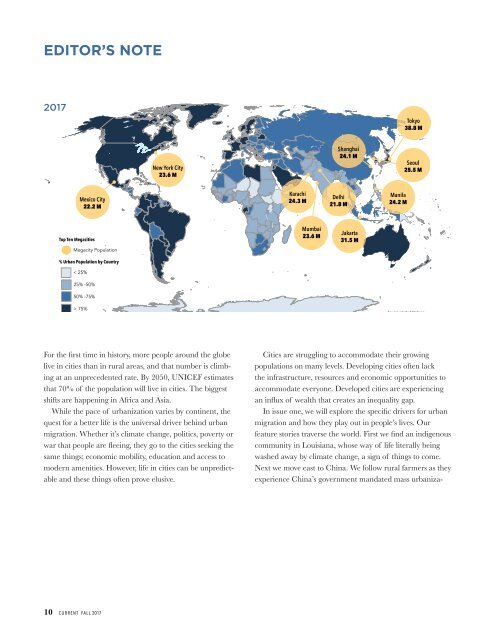Current Magazine
You also want an ePaper? Increase the reach of your titles
YUMPU automatically turns print PDFs into web optimized ePapers that Google loves.
EDITOR’S NOTE<br />
2017<br />
Tokyo<br />
38.8 M<br />
New York City<br />
23.6 M<br />
Shanghai<br />
24.1 M<br />
Seoul<br />
25.5 M<br />
Mexico City<br />
22.2 M<br />
Karachi<br />
24.3 M<br />
Delhi<br />
21.8 M<br />
Manila<br />
24.2 M<br />
Top Ten Megacities<br />
Mumbai<br />
23.6 M<br />
Jakarta<br />
31.5 M<br />
Megacity Population<br />
% Urban Population by Country<br />
< 25%<br />
25% -50%<br />
50% -75%<br />
> 75%<br />
Source: United Nations<br />
For the first time in history, more people around the globe<br />
live in cities than in rural areas, and that number is climbing<br />
at an unprecedented rate. By 2050, UNICEF estimates<br />
that 70% of the population will live in cities. The biggest<br />
shifts are happening in Africa and Asia.<br />
While the pace of urbanization varies by continent, the<br />
quest for a better life is the universal driver behind urban<br />
migration. Whether it’s climate change, politics, poverty or<br />
war that people are fleeing, they go to the cities seeking the<br />
same things; economic mobility, education and access to<br />
modern amenities. However, life in cities can be unpredictable<br />
and these things often prove elusive.<br />
Cities are struggling to accommodate their growing<br />
populations on many levels. Developing cities often lack<br />
the infrastructure, resources and economic opportunities to<br />
accommodate everyone. Developed cities are experiencing<br />
an influx of wealth that creates an inequality gap.<br />
In issue one, we will explore the specific drivers for urban<br />
migration and how they play out in people’s lives. Our<br />
feature stories traverse the world. First we find an indigenous<br />
community in Louisiana, whose way of life literally being<br />
washed away by climate change, a sign of things to come.<br />
Next we move east to China. We follow rural farmers as they<br />
experience China’s government mandated mass urbaniza-<br />
10 CURRENT FALL 2017





